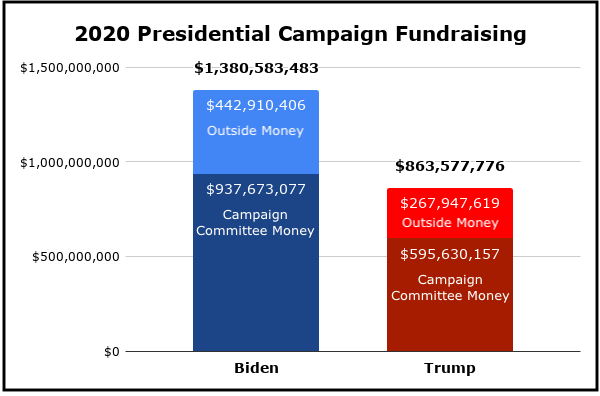2020 Campaign Spending Goes Through the Roof
Washington – The flood tide is still rising, but already the Mega-Money tsunami of Election 2020 is going into the record books as the most expensive election in American history with the biggest flow of dark money ever funneled anonymously to candidates – $750 million, up from a minuscule $5 million a decade ago.
With final spending reports yet to be filed and another $200-$300 million pouring into Senate runoff elections in Georgia, the overall price tag for the 2020 election has already hit $14 billion, according to the Center for Responsive Politics which tracks political money. That stunning total is more than twice as much as four years ago.
We were warned a decade ago to expect this Niagara of campaign cash by Supreme Court Justice John Paul Stevens who bluntly told his brethren on the high court that their decision in the Citizens United case “unleashes the floodgates” by legalizing unlimited campaign spending by corporations and other independent groups.
Joe Biden: A $500 Million Funding Edge Pays Off
Since that fateful decision a decade ago, the numbers have soared exponentially. “Ten years ago, a billion-dollar presidential candidate would have been difficult to imagine,” commented Sheila Krumholz, executive director of the Center for Responsive Politics. This year, it happened.
 Donald Trump, with his billionaire connections, looked like a sure bet to become the first to hit $1 billion, especially when he began fund-raising for re-election almost immediately after taking his oath of office in January 2017.
Donald Trump, with his billionaire connections, looked like a sure bet to become the first to hit $1 billion, especially when he began fund-raising for re-election almost immediately after taking his oath of office in January 2017.
But ironically scrappy Scranton Joe Biden, who was the late-starting, slow-moving turtle in the money race, was actually the one who broke the billion-dollar barrier, amassing a total of $1,380,583,483 for his run for the White House. For a candidate like Biden, who deliberately masked himself and self-isolated because of Covid and ran a thin stump campaign, having a half-a-billion-dollar campaign spending advantage over Trump was crucial.
Biden made his funding leverage pay off handsomely. Time and again, he was able to make up for his lack of vote-pumping, in-person campaign rallies by a steady flow of television, social media, and digital ads to penetrate deep into political battlegrounds and come away with hard-earned victories in pivotal states like Arizona, Georgia, Michigan, Pennsylvania, and Wisconsin.
For Senate Democrats: Spending Does not Equal Winning
But as other Democrats down-ballot learned to their dismay, Mega Money does not always translate into victory. Overall, the Democrats out-raised and outspent Republicans by $5.8 billion to 3.8 billion (not counting the $1.4 billion that billionaires Mike Bloomberg and Tom Steyer spent on their failed presidential primary campaigns).

Top Row: North Carolina – Cal Cunningham (D) v. Thom Tillis (R)
Bottom Row: Iowa – Theresa Greenfield (D) v. Joni Ernst (R)
But bigger bankrolls did not pay off for the Democrats in their desperate attempt to win a majority in the Senate and fatten their House majority. In states like Maine, Iowa, North Carolina, and South Carolina, where Democrats were hungering for victories, they and their SuperPAC allies had bigger campaign war chests than the Republican Senators they were trying to unseat, but all that money did not spare Democrats from disappointing defeats.
In North Carolina, which saw the most expensive Senate race in the history of American campaigns ($285 million), Democratic challenger Cal Cunningham outspent incumbent Republican Thom Tillis by $166 million to $119 million – and still lost. Same thing happened in Iowa, where Democratic challenger Theresa Greenfield outspent incumbent Republican Senator Joni Ernst $111 million to $87 million and then lost by more than 100,000 votes. In South Carolina, incumbent Republican Lindsey Graham also fended off a much better funded Democratic challenger, Jaime Harrison.
How Mitch’s SuperPAC Blocked the Democrats
More often than not, Senator Majority Leader Mitch McConnell with his Republican Leadership Fund SuperPAC was the one who rode to the rescue of endangered Republican senators at the 11th hour. If you’ve ever wondered how McConnell imposes iron discipline on Senate Republicans, take heed of the financial muscle he musters for his troops during the campaign homestretch.

Republican Senate Majority Leader Mitch McConnell
In the 2020 election cycle, McConnell’s SuperPAC, the Senate Leadership Fund, pumped $239 million into Senate campaigns, making his SuperPAC the largest and richest of outside (non-candidate, non-party) spending group in 2020.
McConnell’s SuperPAC was fueled by mega-donors like Las Vegas casino magnate Sheldon Adelson, who was the largest single donor in the 2020 election cycle ($183 million). Adelson and his wife donated $50 million to McConnell’s SuperPAC.
To add to his power and punch, McConnell and his SuperPAC enlisted reinforcement from the closely aligned “dark money” political nonprofit called One Nation, which invested another $75 million in campaign funds to help Republicans maintain their Senate majority while keeping its donors’ names secret.
The Dark Money Boom Foils Reforms
What the campaign of 2020 demonstrated is that despite a decade of reform efforts to halt or expose anonymous campaign donors, the dark money-independent expenditure game is booming. It has become the fastest-growing sector of what Harvard Business School Professor Michael Porter and co-author Katherine Gehl call “The Politics Industry” in their new book.
Because campaign finance laws cap the size of direct donations to candidates and to party campaigns and because the Supreme Court in 2010 blew the lid off outside spending by so-called “independent groups,” which theoretically operate at arms-length from candidates and parties, independent SuperPACs and political non-profits have become the political weapons of choice for wealthy campaign donors.

Outside spending was reported as $2.6 billion in late October. One month later, it was $3 billion.
(Source: OpenSecrets.org)
In 2009, the last year before the Citizens United decision, outside spending by independent groups totaled just $8 million. This year the number exploded to roughly $3 billion, double the amount in 2016. To campaign reform advocates, the most worrisome segment is the skyrocketing flood of mystery money channeled to candidates and campaigns through dark money conduits, which has leaped from $5.2 million in 2008 to $750 million this year.
In order to remain anonymous, donors contribute to political non-profits and limited liability corporations that are allowed legally to hide or disguise their funding sources. These groups then channel their political money to campaign SuperPACs, which are legally required to disclose their funders, but they conceal who actually forked up the campaign cash and simply provide the opaque names of organizations that reveal nothing.
For much of the past decade, Republican and conservative groups have dominated dark money politics. But Democrats and liberal groups reversed that trend in 2018. This year, once again Democrats and the political left provided nearly twice as much dark campaign money as conservatives.
Both sides have evaded campaign reformers bent on exposing or stopping secret funding of campaigns, much as Teddy Roosevelt did a century ago. Foreshadowing the modern reform movement, the trust-busting Republican President railed against what he saw as the corrupting influence on American democracy of candidates’ and parties’ receiving private, fat-cat donations from Wall Street financiers, railroad barons, and oil tycoons.
In words that echo today, Roosevelt declared: “There is no enemy of free government more dangerous and none so insidious as the corruption of the electorate,” The answer to that corruption, TR asserted, was greater openness and banning corporate money in political campaigns, or as he put it, “the enactment of a law directed against bribery and corruption in federal elections.”
An ideal that seems even more elusive in the shadow of the 2020 campaign.


 Hedrick Smith, who conceived this website and is its principal writer and architect, is a Pulitzer Prize-winning former New York Times reporter and Emmy award-winning documentary producer for PBS and PBS FRONTLINE.
Hedrick Smith, who conceived this website and is its principal writer and architect, is a Pulitzer Prize-winning former New York Times reporter and Emmy award-winning documentary producer for PBS and PBS FRONTLINE. 


